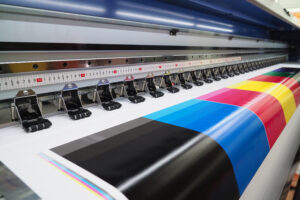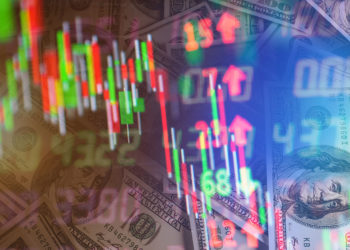A large format printing is often used to stand out amongst the crowd of competitors by having large-scale banners, branded buildings, vehicles, and posters.
A large format printing service near me has a lot of features and peculiarities, which we consider in this article.
Advantages of large format printing
The human brain is organized in such a way that it perceives visual information a hundred or thousand times better than words or sounds. So, around 50% of our brainpower is taken on a daily basis solely by image processing. That’s why visual advertising is so popular and widespread. And a large format print in this circumstance is the best possible way to convey an ad message to your audience.
Who needs wide format printing?
Since most printers are designed to deal with A5 and A4 sheets of paper, a wide format printing might be considered anything that’s larger than that:
∙Promo materials that are given away to people in a location or event (they usually have sizes anything between a business card and a standard newspaper)
∙Maps and construction materials, including blueprints; trade show booth branding (half-human size)
∙Street banners on pillars, signboards, stands, and glass showcases in stores (human-size)
∙Wallpaper, large posters, large-window static banners, vehicle wraps, big boards (from a size of one human to several human sizes)
∙Wraps and banners on buildings and in the air (ads that are dragged behind planes): from several dozen yards to hundreds of yards.
A large format printing will be necessary for your company if you would like to have one or a few ads of the mentioned above. In addition, a wide format printing is doable not just on paper but also on a variety of materials, which might also reflect your business vision:
∙wood
∙metal
∙glass
∙carton
∙vinyl
∙plastic
∙canvas
∙fabric
∙leather
∙tiles
∙foam, etc.
What will you be able to create?
A large format print is made to create large advertisements, which are immediately visible to an eye of many people at once. They have various kinds of bigness and location, but all of them are designed to be seen by passing-by people in a certain spot on a street or a public road. They can be composed of one or more pieces (if the printing width is not enough for 1 piece).
Wide-format printing of modern days actively uses vivid colors, lasting surfaces, and UV-resistant paints.
It is often possible to see combinations of materials in large prints, for instance, a print-covered paper on a big board is combined with 3D elements (from another material) that protrude out of a square shape. And since it is not a problem today to print on uneven surfaces, there exist some really exciting examples of a large format print, which can be even called art because they have stepped out of a purely advertising field.
Two basic types of large-format printers do the job today: flatbed and roll-to-roll. The first will apply a picture on flat surfaces, which can be any material. The second work with flexible, 3-dimensional, and uneven surfaces. Some printing companies also have printers that combine both types in one device.
What format is best for large prints?
A rule of thumb says that the bigger an image in the large format printing is the more pixels are required.
When you print plain text or small pics on an A4 sheet of paper, conventional black-and-white or color printers
would need pixel resolution of only 72-100 dpi (dots per inch) to make it perfectly readable. A crisp picture on a leaflet, booklet, and any other advertising material of A5-A3 sizes, however, already needs to be at least 300 dpi to avoid having the so-called “pixelation” (although working samples might be perfectly fine with just 150 dpi). A higher resolution is chosen for large format printing, where there is a need to keep the crispness and color saturation of a picture, as a piece of paper or another bearing material gets bigger than a medium format of digital printing (dpi might go up to 600 and even 1200).
The same approach to dpi resolution goes for large format digital printing — those ad pieces you see on the city lights, road boards, posters, banners, vehicle wraps, building covers, and other large things, mustn’t be blurry or pixelated.
How do I prepare large format for printing?
Most large format printing companies in the UK require a specific file format from customers.
If it is in raster graphics, file types for small, medium, and large format printing usually are:
∙TIFF
∙JPEG/JPG
∙PNG
∙GIF
∙BMP
∙RAW.
In all cases, the dpi is recommended not less than 300, so the bigger the large format printing is in inches or feet, the bigger size the file will be. Bear in mind that BMP and RAW are uncompressed formats, so not every large format printing company accepts them. But they are sometimes needed for the ultimate quality of printing and pre-processing.
If there is a need to make graphics in visual advertising look the same crisp and super sharp independently of the size of the large format printing across all possible sizes of small, medium, and large format printing, on all flat and curvy surfaces, and avoid the change of the side ratio, then vector graphic is used (file format is
SVG). It is technically possible to convert any image into vector graphics for large format print but usually, logos and schematic drawings are best for that. And then, no matter how large the end result of your large format print will be, with SVG, the image remains crisp and does not become too heavy in size even when enlarged.
Customer Benefits
The first obvious benefit of wide format printing is immediate visibility to people around. Using large-scale printing, it is possible to become distinct from your competitors and other businesses around.
A small-size business could create an illuminated signboard with its logo that will shine in the dark and combine it with a street banner or a city light showing its location.
Large businesses actively use big boards and vehicle wraps today to inform about their hot offers and marketing events.
Construction companies use building wraps and fence banners to show what will a built or renovated building look like after completion (and also to hide the ugliness of a construction process).
When you really think of possible applications of large advertising, you find them so immense that it becomes hard to find a type of business, for which, its usage would not be necessary.
Read more:
Large Format Custom Printing Facts You Need to Know
















